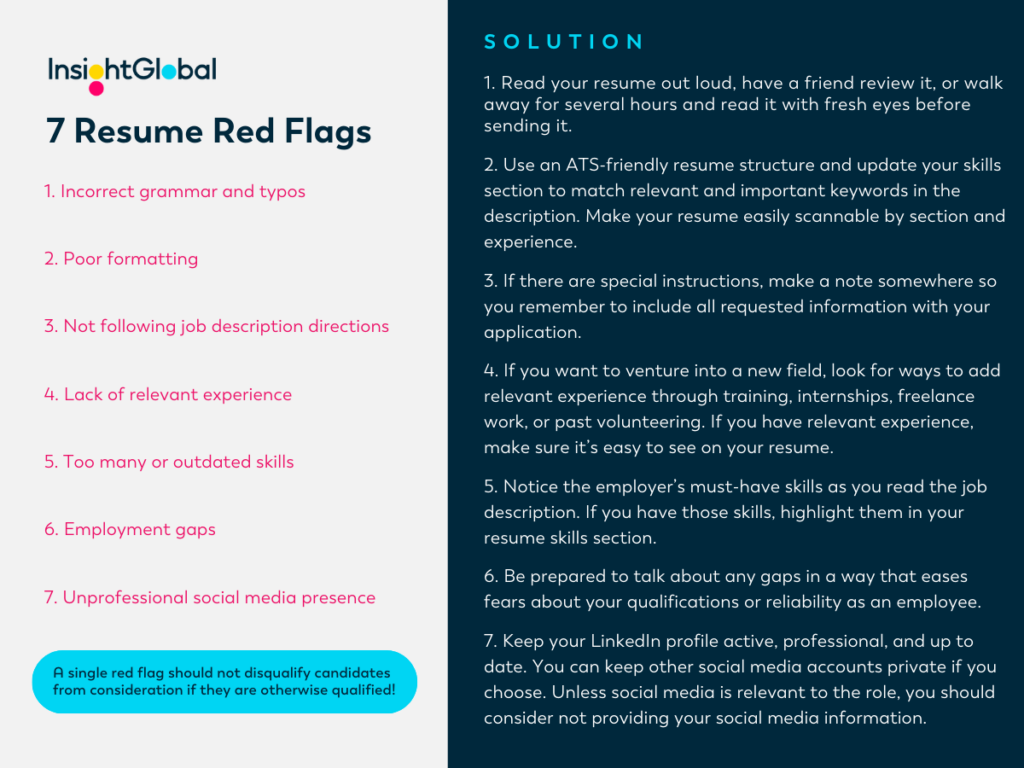For hiring managers and candidates, a resume is an essential step in a complex process. It’s often the first point of contact where the candidate can make a strong impression, and for the hiring manager, it’s a tool to screen potential fits for the role. In both cases, it’s vital to understand common resume red flags.
If you’re a job seeker, red flags on your resume may prevent hiring managers from calling you in for an interview. If you’re a hiring manager, these red flags could signal a greater trend about a candidate.
A single red flag on a resume should not disqualify candidates from consideration if they are otherwise qualified. However, it’s good to notice and ask for context.
Resume Red Flags
Here are seven resume red flags, including how job seekers can correct them.
1. Incorrect Grammar and Typos
Mistakes, typos, and grammar errors on a resume can be a red flag. A single typo or two shouldn’t be disqualifying, but typos throughout the document make it harder for a hiring manager to read a resume and understand the candidate’s experience.
How job seekers can address it: A job search can be exhausting and time-consuming, but it’s better not to rush. Don’t assume that spellcheck or typing assistants are picking up all potential errors. Read it out loud, have a friend review it, or walk away for several hours and read it with fresh eyes before sending it.
2. Poor Formatting
Most hiring managers and recruiters use Applicant Tracking Systems (ATS) to scan resumes as they come in. The ATS seeks relevant skills and experience to find the most qualified candidates for further review. Your format, length, and font choice should be easy to scan.
A poorly formatted resume can be self-defeating. It makes it hard for people and the ATS to find the information that qualifies the candidate for the role.
How job seekers can address it: Use an ATS-friendly resume structure and update your skills section with each submission to match relevant and important keywords in the description. Make your resume easily scannable by section and experience.
3. Not Following Job Description Directions
Job postings sometimes give special instructions. For example, they may ask candidates to apply on the company site or include specific information in their cover letter or email. Disregarding or failing to notice those instructions may be a red flag.
If you are a hiring manager and notice that a large percentage of applicants are not following your special instructions, check the job site to make sure they are visible on the job listing.
How job seekers can address it: Read each job description carefully, all the way to the end. If there are special instructions, make a note somewhere so you remember to include all requested information with your application.

4. Lack of Relevant Experience
Job seekers need to highlight the work experience that is relevant to the position they’re applying to. There are several reasons a candidate may seem to lack relevant experience on their resume. These include:
- They have experience but haven’t made it clear on the resume
- They are not thoroughly reading job descriptions before applying
- They are unclear about their career goals
- They want to make a career change and don’t have experience in this area yet
- They are new to the workforce
How job seekers can address it: Select job postings that match your skills and experience. If you want to venture into a new field, look for ways to add relevant experience through training, internship, volunteer work, or freelance. If you have relevant experience, make sure it’s easy to see on your resume.
5. Too Many or Outdated Skills
A resume skills section should be no longer than 10 and 20 relevant skills. A long list of skills or common skills like “email” or “Google Docs” can be a red flag on a resume, especially if it looks like you’re stuffing skills to fill out a section.
Candidates should list their most relevant and valuable skills to the job. Ideally, each resume will be slightly customized so the relevant skills they submit align with the employer’s needs and wants.
How job seekers can address it: Notice the employer’s must-have skills as you read the job description. If you have those skills, highlight them in your resume skills section.
6. Employment Gaps
Employment gaps are not uncommon and shouldn’t necessarily disqualify a job seeker. There are plenty of valid reasons for a gap that are not indicative of how a candidate will perform. However, it is fair for a hiring manager to ask about gaps and job seekers should be prepared to explain gaps.
Employers should look at employment gaps within the context of a candidate’s entire resume. When looking at a resume with employment gaps, employers should factor in the number of gap(s), whether the gap(s) were recent, and whether the candidate can show subsequent and/or steady employment otherwise. Regardless, if a candidate’s skills and experience match your needs, you can investigate further with a phone call or interview instead of making negative assumptions about gaps.
How job seekers can address it: Be prepared to explain your employment gaps. Hiring managers are people too and a good employer will lead with empathy and hear your reasoning. That still means that you need to prepared to talk about the gap in a way that waylays any fears about your qualifications or reliability as an employee. If you have an opportunity to submit a cover letter, it is worth considering whether you should address your gap(s) there.
7. Unprofessional Social Media Presence
Many hiring managers search the web for candidates before or after an interview, and some candidates provide their social media on their resumes. When hiring managers research social media, they are looking for posts or content that indicates that if a candidate is hired, they will act unprofessionally, demonstrate poor judgment, or otherwise embarrass the employer.
How job seekers can address it: Keep your LinkedIn profile active, professional, and up to date. Most recruiters and employers look there first! You can keep other social media accounts private if you choose. If you chose to keep your social media accounts public, you should assume that they will be viewed by potential employers and keep that in mind when posting content. Unless social media is relevant to the role, you should consider not providing your social media information.
Find the Perfect Match
The purpose of any job search is to find a skilled, capable candidate that matches the role and complements the company culture. For candidates, this means making it easy for hiring managers to recognize your skills and experience. For hiring managers, this may include overlooking a single red flag to dig deeper into the person behind the resume.
As a people-first recruiting agency, we are dedicated to helping individuals progress in their careers while pairing top candidates with open positions.
Contact us to find new opportunities or find qualified candidates. We make hiring and finding jobs easy.


 by Patrick Glynn
by Patrick Glynn 

 by Alexandra Woodford
by Alexandra Woodford 
 by Erin Ellison
by Erin Ellison 
 by Brita Long
by Brita Long 
 by Anna Morelock
by Anna Morelock